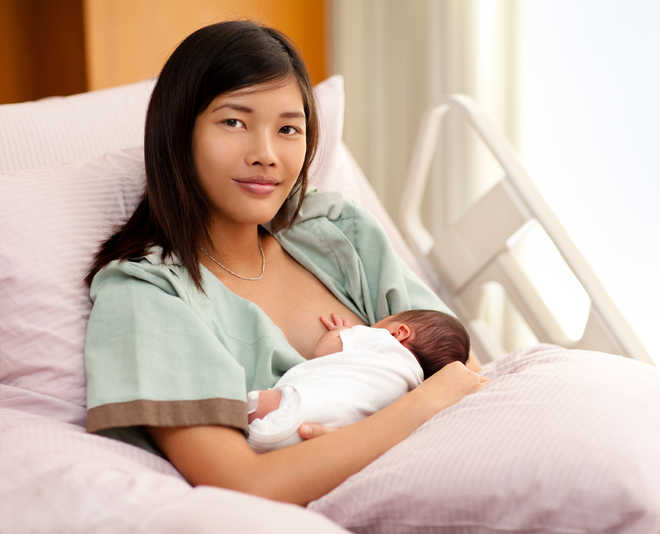Dr Shacchee Baweja
Breastfeeding is the purest, safest and most sustainable way to feed an infant. In view of its huge benefits for both infants and mothers, exclusive breastfeeding up to six months and continued breastfeeding for at least two years for all infants have been strongly recommended.
Breast milk is not just a perfect combination of nutrients but it is also a live tissue with many immune factors which gives a baby continuous, active protection against various infections. Breastfeeding is protective against problems such as respiratory illnesses, asthma, eczema and ear infections in infants. For mothers it helps in losing weight, reduces the risks of post-partum hemorrhage, postpartum depression, protects against risks of breast, ovarian and uterine cancer and also reduces chances of heart disease and type 2 diabetes.
Golden hour
The first hour after birth when a mother has uninterrupted skin-to-skin contact with her newborn is referred to as the “golden hour.” Studies show that if a mother and new-born baby are in skin to skin contact during this time, it helps with early establishment of breastfeeding and also impacts a mother’s eventual milk supply. Breast feeding a baby early can also speed up the delivery of the placenta, thus reducing the risk of postpartum hemorrhage.
Myths & facts
Myth: Majority of women do not produce enough milk.
Fact: Except for a few women with primary lactation insufficiency, majority of mothers are capable of producing sufficient milk for their babies.
Myth:Breastfeeding hurts.
Fact: Normally, breastfeeding never hurts if done correctly. If breastfeeding is painful, a mother should seek help from a trained breastfeeding counsellor.
Myth: There is a dearth of milk during the initial days after birth.
Fact: The milk during the initial days is less but is always sufficient for the baby and if the baby is positioned and latched well at the breast, s/he will get enough.
Myth: A mother cannot feed for first two days post-Caesarean birth.
Fact: A mother can breastfeed her baby even right after surgery. Even after a C-Section, there are various other positions besides getting up or turning on side in which a mother can feed.
Myth: Breastfeeding leads to saggy breasts.
Fact: Saggy breasts can be a result of many things like pregnancy, obesity, heredity and aging.
Dwindling numbers
An increasing number of new mothers are giving up breastfeeding completely. Lack of skilled and timely lactation support in the hospitals, lack of widespread awareness, and indiscriminate use of formula milk in hospitals are the main reasons most new mothers are facing difficulties in establishing breastfeeding. Lack of family support, increasing number of pre-term and Caesarean deliveries, previous breastfeeding difficulties, myths surrounding breastfeeding are some of the other common factors responsible for mothers failing to breastfeed.
Just eat healthy
Researchers have proved that what a mother eats does not have any impact on her milk supply and does not affect her baby in any way. A balanced diet, including the normal regional cuisine of that family is recommended. As a mother’s body uses lots of calories in making milk, she will feel hungry more often, it is recommended that she should eat nutrient-rich food as between-meal snacks like roasted lotus seeds (makhana), unsweetened dry fruits, fresh seasonal fruits and salads. No food needs to be restricted.
Breastfeeding positions
There is no one ideal position, any position which is comfortable to the mother at any particular point of time is the best breastfeeding position. The mother should be comfortable and well supported before she puts her baby to breast.
An unswaddled baby when put to breast in a way that he / she can take a large mouthful of mother’s breast in his/her mouth feeds well and will never cause pain to mother. Persistent pain to mother while breastfeeding her baby is an indicator for some problem with baby’s latching.
Production principle
Milk production starts at around 16-18 weeks of pregnancy and once the placenta is delivered, milk release starts happening. Most of new mothers worry about their milk supply and feel that they have no milk as the breasts feel soft for initial couple of days. If the baby is regularly feeding at breast, without causing any pain, passing regular urine and stools and in general is comfortable in between feeds, in all probability the baby is getting well fed. By day 3 or 4, the breasts start feeling fuller and mother becomes confident of feeding the baby..
If due to any reason, a baby is separated from the mothe or is not breastfeeding, she should start expressing breast milk either using hands and continue doing so at 2-3 hourly intervals till the baby can suckle at breast.
Common problems
- Dissatisfied baby after breastfeeding
- Painful feeding
- Sore/ cracked nipples
- Engorgement
- Block ducts
- Fungal infections
- Mastitis
All these problems point towards poor attachment and inadequate milk transfer at breast. Seek guidance of a trained lactation consultant and not gynaecologist or paediatrician.
Risks of not breastfeeding
For Infants
- Higher rate of diarrhoea, respiratory infections and ear infections.
- Higher risk of allergies.
- Higher risk of obesity, diabetes and many types of blood cancers.
- Higher risk of Sudden Infant Death Syndrome.
- An increased risk of necrotising enterocolitis in premature babies.
For mothers
- Higher risk of postpartum depression.
- Higher risk of postpartum bleeding.
- Higher risk of anaemia.
- Higher risk of bone loss.
- Higher risk of obesity, diabetes, high blood pressure.
- Difficulty getting back into pre-pregnancy shape.
- Higher predisposition to many types of cancers.
— The writer is lactation consultant, BLK Super Speciality Hospital, New Delhi
Unlock Exclusive Insights with The Tribune Premium
Take your experience further with Premium access.
Thought-provoking Opinions, Expert Analysis, In-depth Insights and other Member Only Benefits
Already a Member? Sign In Now











